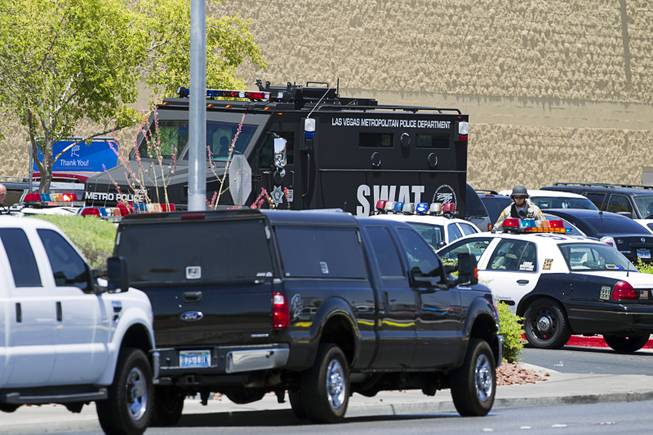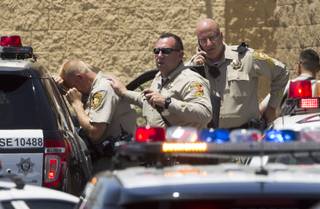
A Metro Police SWAT vehicle is shown outside a Wal-Mart on Nellis Boulevard Sunday, June 8, 2014. Two suspects shot two Metro Police officers in a nearby pizza shop then fled to the Wal-Mart where they shot and killed another person, police said. Both officers died of their injuries.
Friday, May 6, 2016 | 2 a.m.
Related stories
- Anti-government killers put swastika, flag on Metro police officer's body
- Two officers, three others dead in shootings at restaurant, Wal-Mart
- A look at Metro officers who died in the line of duty
- Politicians offer condolences in tragedy’s aftermath
- Cliven Bundy’s son: Las Vegas shooters kicked off ranch
- How you can help Metro Police in their time of mourning
- Shooters identified in slaying of Metro Police officers, bystander
Miscommunication hampered Metro Police's response to the June 2014 slaying of two officers and a bystander in the east Las Vegas Valley, according to a report released Thursday by the U.S. Justice Department.
The two anti-government assailants died in a shootout with police inside a Wal-Mart.
Also according to the report:
The findings include Metro’s call center and dispatch being burdened by an excessive number of calls seeking updates, a lapse in command structure, radio interference and overconvergence of officers at the scene.
Metro in the report was also praised for its “dedication to preparedness and training that helped minimize further deaths and injuries” the morning of June 8, 2014, when officers Alyn Beck, 41, and Igor Soldo, 31, were fatally shot while eating at CiCi's Pizza at 309 N. Nellis Blvd. and good Samaritan Joseph Wilcox was fatally wounded while trying to stop the assailants, Jerad and Amanda Miller, when they entered the Wal-Mart across the street.
The Millers died in a shootout with officers; police shot Jerad Miller and Amanda turned the gun on herself.
Communication center
After the officers were shot, the initial call to dispatch at 11:21 a.m. was misclassified and the center communicated a 415A incident code (used for a shooting) over the airwaves as opposed to 444 (used for officer emergencies).
Specialists typically handle the 444 calls, which require further training than what normal call takers obtain. Two dispatch supervisors were at lunch when the shooting was reported.
Dispatch and 911 centers were “burdened” by high call volume from Metro personnel seeking updates. “LVMPD personnel understandably wanted to ensure that they had the most up-to-date information as the incident unfolded,” the report read. “But it’s not an effective practice.”
The DOJ recommended Metro update its information-sharing procedures for critical incidents so the facts go out to the required staff in a timely manner. It also recommends software that prompts call takers' essential commands and questions during such incidents.
Also because the officer-involved shooting was initially misclassified and the SWAT commander wasn’t on the information distribution list, that person wasn’t notified about the incident until about 10 minutes after the call came in.
Arriving officers
There was an “overconvergence” of officers who responded to the scene when the shooting was reported, perhaps leaving their area commands unprotected in the case of another critical incident.
“It is understandable that officers want to self-report to the incident to provide assistance, but strong supervisory direction and incident command can reinforce dispatch protocols,” the report said.
The dash to the scene could have been prevented had Metro established its “MACTAC” (multiassault counterterrorism action capabilities) protocols a few minutes earlier. This would have set rally points and established procedures.
Police equipment
Arriving SWAT officers entered Wal-Mart wearing “crisis dress,” which is tactical gear on top of street clothes. However, their outfits resembled that of Jerad Miller, which could have caused confusion, the report said.
They were guided by good “tactical” information and it was radioed that they were donned in civilian clothes, but Metro has since eliminated crisis dress and requires officers to respond in full police garb.
It was recommended the department trains its officers on equipment acquisition and make suits, helmets and rifles more easily accessible.
Radio problems
Officers encountered confusion over the police airwaves.
The communication between tactical teams was being transmitted along with the perimeter traffic, letting anyone with access to the channel, perhaps even the Millers, know about police movements inside the store.
Not every officer transitioned channels when they were separated, which caused further confusion.
Metro has not made a formal policy change regarding splitting its channels during active-shooter situations.
“Garbled transmissions” hampered information sharing during the incident, the report said. Officers interviewed reported difficulties with the audio quality of their radios, which “created a dangerous situation during tactical deployment coordination.”
The radio company, which Metro had used starting in 2010, was replaced before the end of 2014.
Some of the officers who made their way into the store chose earpieces over the traditional radios to “protect themselves.” The move proved effective in reducing the chance of leaking tactical information over the airwaves.
Incident command system
Instead of coordinating and establishing a staging area, the watch commander on shift during the shooting, a lieutenant, “inserted himself” into the perimeter team, leaving a sergeant as the incident commander.
The sergeant initially performed “admirably,” but there was confusion with the coordination of the response teams and chain of command. An off-duty lieutenant eventually arrived and established order, the report said.
MACTAC
The report praised Metro’s “robust training programs,” which were established in 2011, about three years after the terrorist attacks in Mumbai. Each year, officers engage in real-life training scenarios like calls of officer down or ambushes.
Officers interviewed for the report said, “This what we train for” and “I could fall back on my training.” Even when they entered the store with officers from different units, the response was swift.
Public information after the shooting
Also praised was the way the police department handled information and released it in a timely manner to avoid speculation. Within hours, then-Sheriff Doug Gillespie briefed the media and identified the officers. The information continued to flow the days following the shootings, through news conferences, releases and social media posts.
“By regularly updating the media — and thus the greater Las Vegas community, the LVMPD exemplified best practices for information sharing,” the report said.
Two-officer patrol and morale
After the shooting, Metro leadership established that patrols would be one by two officers per vehicle instead of one. This practice made officers feel supported and with a greater sense of safety, the report said. This practice continues every time an officer is targeted or when national climate suggests an attack is imminent.
The report also praised the way Metro leadership made in-person appearances to Beck and Soldo’s area command to boost morale. The department also made available counseling resources.
The federal agency’s Office of Community Oriented Policing Services assembled the report after Gillespie requested it, and conducted it with cooperation from Metro Police, the DOJ said, noting that the report can help police departments nationwide better prepare for similar situations.
Metro reaction
The police department has reviewed its practices extensively since the day of the shooting and the findings are not a surprise, spokeswoman officer Laura Meltzer said.
It was healthy for the department for an outside entity to review and publish the report, she said.
There were lessons learned from the shooting, she said. “Everybody learned things that day that nobody ever wanted to.”


Join the Discussion:
Check this out for a full explanation of our conversion to the LiveFyre commenting system and instructions on how to sign up for an account.
Full comments policy